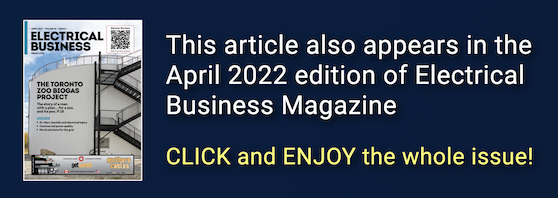
Features
Articles
Wiring - Cabling - Devices
Power protection is about proactively mitigating and managing the risk to equipment
December 2, 2021 | By Michael Creighton
You may be surprised to learn that storms and other natural occurrences are not the primary cause of power problems.
 Photo : Adobe Stock / cherylvb
Photo : Adobe Stock / cherylvb December 2, 2021 – Electrical engineers understand better than anyone the importance of quality electrical power in driving business forward. Power quality is more vital now than ever, as the pandemic transitioned many of the last vestiges of pre-digital productivity onto networked devices and platforms, meaning poor power can no longer be functionally worked around.
In the past, a school could have students read reports; an office could have workers organize files; a clinical lab could have technicians perform data entry. All of these tasks are now done digitally, which means their operations grind to a halt when the power is unreliable.
With that in mind, it is worth correcting a few misconceptions about power quality so that engineers, electricians, operators, and others provide customers with the most reliable experience possible.
Bad weather is only a small piece of the puzzle
When catastrophic power events are brought up, the mind naturally conjures up images of thunderstorms or floods, but you may be surprised to learn that storms and other natural occurrences are not the primary cause of power problems. Anything that runs on electricity will create noise in a power environment, including other machines in the vicinity, the building’s HVAC system—even overhead lighting.
These systems are necessary to keep building operations up and running, but they can also produce electrical impulses, high-frequency noise, and high-voltage transients. This noise leads to variance in power quality—irregular swells, sags, and spikes in the smooth sinewave electrical engineers prefer to see.
That variance can easily disrupt sensitive electrical equipment in a way that can be hard to detect in real-time, largely because many believe that power availability is the same as power quality.
Power availability has little bearing on quality
While the inability to turn the lights On certainly indicates that a power environment has been compromised, the lights being On should not be taken as evidence of a clean and consistent power environment. The simple truth is that systems are actually most vulnerable when the power is On.
Spikes, normal-mode noise, and common-mode noise are present to some degree all the time when power is On. Spikes are simply temporary surges that can overload a system, whereas noise is consistent, unwanted voltage impulses, separated as either normal-mode noise or common-mode noise.
Normal-mode noise is caused by large loads (e.g. heavy machinery or manufacturing equipment) being switched On and Off. Common-mode noise is caused by inclement weather, switching breakers, and poor grounding, but can also stem from surge protectors that only divert surges rather than eliminate them.
These power issues aren’t as dramatic or memorable as a blackout from a thunderstorm but, if left unchecked, these disturbances can lead to downtime, data errors, inaccurate measurements, shortened equipment life, and increased service calls.
Pricy products aren’t built to survive dirty power
While you might assume that costly equipment is built to handle a bit of wear and tear, this is decidedly not the case with highly calibrated, sensitive electronics. Dirty power won’t necessarily destroy equipment, just as low-octane gasoline won’t crash your car. The negative issues come in the form of degradation, system lockup, undetected data logic errors… all of which contribute to the slow erosion of system components and performance levels.
In a way, these problems are actually worse than an outright crash, because you could act on inaccurate readings without knowing your equipment results are flawed.
These are issues that commonplace power products like basic surge protectors and backup generators are not equipped to address. True protection comes from power-conditioning solutions that are capable of isolating connected equipment from the power provided by the grid to help maintain operations and uptime.
A surge protector and generator are not enough
Surge protectors are designed to divert high-voltage impulses away from the sensitive electronic systems they protect, but they do not actually eliminate the impulse. This means the power problem persists and the system continues to strain. Many surge protectors are also (functionally) one-time-use only, or degrade over time, with performance subject to their respective clamping voltage and response times.
Surge protectors are useful—especially in the residential or light commercial markets—but they don’t offer enough reliable and repeatable protection for more robust commercial and industrial environments, which demand more comprehensive solutions that include a surge diverter, a noise filter, and a low-impedance isolation transformer.
Surge diverters take high-voltage transients and divert them safely away from your electronic system, while noise filters protect systems from the high frequency normal-mode noise noted above. A majority of commercial-level power protection solutions deploy a surge diverter, noise filter, or both, but the most important element of power protection is actually a low-impedance isolation transformer.
This specialized feature acts to isolate the powered instrument from the power source and re-establishes the neutral-ground bond without opposing or disrupting the current path. This eliminates common-mode noise and ensures that the logic ground (or decision-making reference) for the computer is not disturbed. The device is then truly protected from unwanted noise without negatively affecting power flow. This ensures only clean, reliable power consistently flows to and through your devices.
Backup generators are similarly insufficient as surge diverters, as they can take up to 45 seconds to start up and supply power, which is an eternity to unprotected, sensitive electronic systems. An uninterruptible power supply, on the other hand, not only delivers reliable, clean power when active, but also features a low-impedance isolation transformer with a high load inrush capacity to ensure equipment is never disconnected from clean power.
Clean power saves money, time, and reputation
For example, one of our customers is a global leader leader in ATM systems. They were seeing an increase in service calls due to system lockups, lost communication, and “ghost jams”, which not only increased costs, but resulted in delays in processing time, downtime, and the perception of a negative customer experience.
Without a proper power quality solution, the OEMs reputation and bottom line were at risk. They dedicated an allowance of 8% of annual revenues—$10.8 million in the year in question—toward equipment-servicing during the offered warranty period.
However, after introducing power-conditioning products across the board, their equipment-servicing expenses for the year were reduced by 43% (over $4 million in savings), vastly outweighing the cost of the implemented solutions.
In another case, we work with a major OEM in the dental imaging space that specializes in highly calibrated, technologically complex dental X-ray instruments. A significant threat to these sensitive devices is data anomalies caused by poor power quality, which can alter image quality and, therefore, affect patient diagnoses. This can adversely affect the patient experience if multiple images are required for an accurate diagnosis.
Service costs escalate when these problems occur, and the OEM’s instrument is perceived as the cause—even though poor power quality is the real culprit!
It stands to reason, then, that on sales of $200 million, this customer allocated close to $12 million for service costs. However, after the integration of power-conditioning solutions, the OEM saved 70% on service costs.
At the end of the day, power protection is about proactively mitigating and managing the risk to equipment from power-related failures including performance degradation, erosion of sensitive conductors, components, and circuits from low-amplitude power disturbances and surges.
In each case, the point is clear: it’s bad business to wait for electrical issues to happen, which means the electrical experts that serve them need to be proactive.
Michael Creighton has three decades of experience in engineering, R&D and innovation in the power management industry. He joined AMETEK Powervar in 2012 as director, Engineering, where—among other things—he is responsible for leading the team in the development and improvement of power supplies, facilitating strife testing and using root-cause analysis to build and adapt products.
You’ll find all our Back Issues in the Digital Archive.
Print this page
